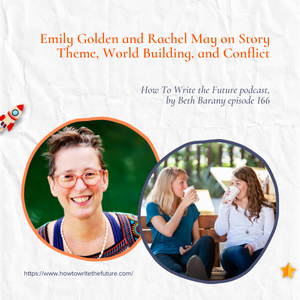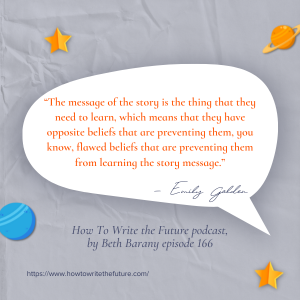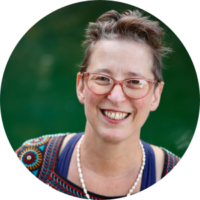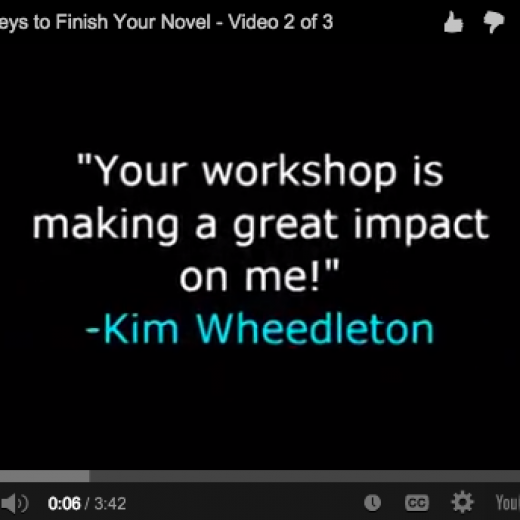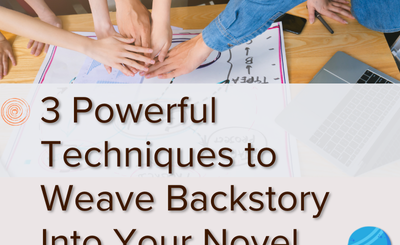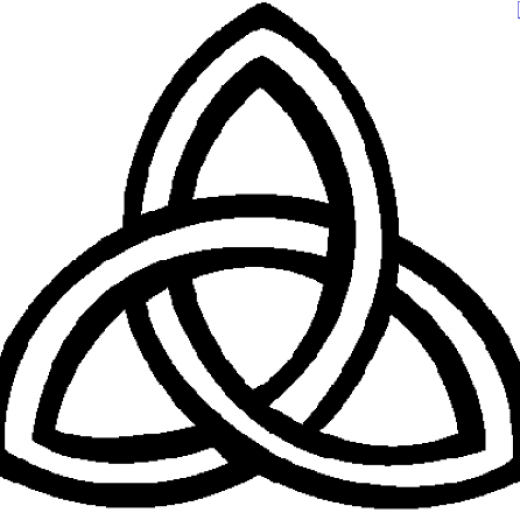Emily Golden and Rachel May on Story Theme, World Building, and Conflict
Emily Golden and Rachel May on Story Theme, World Building, and Conflict – How To Write the Future podcast, episode 166
***
“The message of the story is the thing that they need to learn, which means that they have opposite beliefs that are preventing them, you know, flawed beliefs that are preventing them from learning the story message.” – Emily Golden
In this special episode of How To Write the Future, host Beth Barany chats with Emily Golden and Rachel May about story theme, world building, and conflict. They share their collaboration journey and touch on diving into character arcs and the messages that drive stories. Plus, they explore why asking “why” is so crucial to helping writers develop their unique character arcs for their stories.
Platforms the podcast is available on: Apple Podcasts | Buzzsprout | Spotify | Amazon Music| YouTube
RESOURCES
FOR CREATIVE WRITING PROFESSIONALS – BUILD YOUR BUSINESS SERVING WRITERS
Sign up to be notified when our training opens and get a short Creative Business Style Quiz to help you create success.
https://bethbarany.com/apprenticeship/
Support our work for creatives!
Buy me a coffee: https://ko-fi.com/bethbarany
GET HELP WITH YOUR WORLD BUILDING – START HERE
Free World Building Workbook for Fiction Writers: https://writersfunzone.com/blog/world-building-resources/
GET SOME FREE WRITING COACHING LIVE ON THE PODCAST
Sign up for the 30-minute Story Success Clinic with Beth Barany: https://writersfunzone.com/blog/story-success-clinic/
GET SUPPORT FOR YOUR FICTION WRITING BY A NOVELIST AND WRITING TEACHER AND COACH
Schedule an exploratory call here and see if Beth can support you today: https://writersfunzone.com/blog/discovery-call/
About the How To Write the Future podcast
The How To Write The Future podcast is for science fiction and fantasy writers who want to write positive futures and successfully bring those stories out into the marketplace. Hosted by Beth Barany, science fiction novelist and creativity coach for writers. We cover tips for fiction writers.This podcast is for readers too if you’re at all curious about the future of humanity.
This podcast is for you if you have questions like:
– How do I create a believable world for my science fiction story?
– How do I figure out what’s not working if my story feels flat?
– How do I make my story more interesting and alive?
This podcast is for readers, too, if you’re at all curious about the future of humanity.
ABOUT EMILY GOLDEN AND RACHEL MAY, BOOK COACHES
Emily Golden and Rachel May are the founders of Golden May. Their joint love of amazing stories and mutual fascination with writing craft evolved into a book coaching business devoted to helping tenacious writers develop the unique writing craft, process, and mindset that works for them—because every writer is different. If you’re ready to stop fighting what your writing life ‘should’ look like and start dreaming about what’s possible for you, they’re the coaches for you!
Get the goodie: THE MAGIC OF CHARACTER ARCS: A free email course to craft the backbone of your story. https://goldenmayediting.com/arcsmagic
Site: https://goldenmayediting.com
Community program: https://www.tenaciouswriting.com/
INSTAGRAM:
https://www.instagram.com/ebgoldenbooks
https://instagram.com/bookcoachrachel
https://instagram.com/tenaciouswriting
SUBSTACK:
https://ebgolden.substack.com/
Transcript for episode 166 Emily Golden and Rachel May on Story Theme, World Building, and Conflict
Introduction and Guest Welcome
BETH BARANY: Hey everyone. Welcome back to How To Write the Future Podcast. I’m your host, Beth Barany. I’m a writing teacher, coach, editor, and also science fiction and fantasy writer. I’m excited to bring two people who together make one unit. They told me they’re one brain. I’m so excited to bring you both in.
[00:18] Meet Emily Golden and Rachel May
BETH BARANY: We have Emily Golden and Rachel May. Welcome.
EMILY GOLDEN: Hi. Thanks so much for having us.
BETH BARANY: Yeah. I’m so excited. Let me read your bio so everyone can know who you are.
Emily Golden and Rachel May are the founders of Golden May. Their joint love of amazing stories and mutual fascination with writing craft evolved into a book coaching business devoted to helping tenacious writers develop the unique writing craft process and mindset that works for them. Because every writer is different. If you’re ready to stop fighting what your writing life should look like and start dreaming about what’s possible for you. They’re the coaches for you.
I love your bio so much. I am totally in line with your philosophy.
RACHEL MAY: Welcome to Golden May.
BETH BARANY: Thank you.
RACHEL MAY: Pleasure to have you. Take you in. Come on in. We are now. Golden May Barany. We edit, we coach, we write.
EMILY GOLDEN: We have a community.
BETH BARANY:That’s so wonderful. It’s so so wonderful.
[01:16] Discussing Theme and Message in Writing
BETH BARANY: Well let me put myself on the spotlight here and ask you, the first question and, and this will be free flow, free flowing.
Since I help primarily science fiction and fantasy writers, but also character driven writers, something that people struggle with and also I never come up with until I’m in editing toward final edits and sometimes not even then, which is theme. Some people get a little angsty about themes.
Some people are really good at deciding what is their story theme, but some people really do have a message also.
So how would you distinguish theme versus message and how do you define theme? And I guess my big question is also: Why theme? How is it important?
RACHEL MAY: Do you wanna start, Emily?
EMILY GOLDEN: Sure. Yeah. I can take it.
RACHEL MAY: Great.
EMILY GOLDEN: Yeah. So theme is one of those things that I always struggle with ’cause it’s so amorphous, right? It’s just this: what are your themes? And so we often talk about what Lisa Cron calls the story point.
Where it’s the message of your story essentially, right?
That’s how Lisa defines a story point, is, you have something that you’re trying to teach your reader, or through your characters, right? Your character learns a lesson and therefore your reader learns the lesson through their experience.
And so it’s this takeaway from your story. It’s what your story is about at its core. And then I like to think of theme as sort of the pieces of the story point.
So, I wrote down some examples ’cause I feel like it’s, the definition’s hard. So let’s say, if we take the first Game of Thrones novel, for instance, right?
We have that story point of that book is that there’s no room for honor in the game for power.
And so the themes that are kind of baked into that story point are themes of power. We’re gonna explore, like what is power, what is honor? How are those things related, themes of politics and the games that are played in politics.
And so I like to think of, your story doesn’t usually have one theme. It’s usually looking at the intersections of different themes, right?
The intersection of family and love, or the intersection of perfection and belonging, right? And exploring how those themes work together.
And so I think often times when folks try to start with theme it feels a little bit too amorphous, but if you can start to think through what is the actual takeaway that I want my book to have, then you get to explore what are the themes that are baked into that, and are those the themes that I wanna explore. Anything to add, Rachel?
RACHEL MAY: I remember learning about theme in like eighth grade, right? Where your English teacher asks you to read a novel and tell me what are the themes of this book? And you’re like, I have no clue. I think that carries into this process of like, I wish I could tell you what they are.
And I know when I first started writing, I remember very distinctly filling out like a character interview sheet or like a novel planning sheet. And one of the questions was what are the themes of this book? And being like, hell if I know, I don’t know. I haven’t written it yet.
So I really align with what you were saying, Beth, of sometimes I don’t think you can truly see what this book is about until you’ve read it. I remember feeling like, if I don’t know what it’s about, how am I ever gonna write it? But I think the difference of what, when I learned what the story point was when I went into Lisa Cron’s teachings and understood that is a specific message that you aim towards, that gives your story cohesiveness.
Then I started to understand okay, so if the point of my story is that Love heals all wounds, and I want my reader to learn that, and I want my characters to learn that. Then I have something to aim towards with my story choices. But if I just say, this story’s about love. Okay, what about love?
How, why? Like, where are we going?
So I think getting more specific with a story point or with a message of your story just helps you focus, it gives you some focus, and it gets refined over time. I don’t think I ever truly know what the themes of my story are, or even what the message of my story is until after the second, or like the first draft. The second draft. I think I usually go into it with like, I’m aiming for something like this. Let’s see what happens.
Because it, it changes, it shifts, especially for me, when my characters take on life and a journey of their own and their flaws come to light. So it’s very impactful to give your story cohesiveness, but there’s not any one right place where you need to know what it is.
I think discover these things and they firm up the further you get into the process.
BETH BARANY: Yeah, that’s great.
I really appreciate what you’re all saying here about theme and message because I too, I have clients who angst about this, who worry about this.
And I co-teach with my husband and he usually decides on theme as he’s planning. ’cause he is more of a plotter, whereas I discover it toward the end of revisions and then again, also sometimes, not even until the book is published and people are like, oh, you’re writing about this.
I just wanna shout out to Lisa Cron. I have her books. I met her. I love Wired for Story. I have two of her other books, which I haven’t yet read, but I am often referring to things that she said as well. And so it’s really wonderful that you’re both using her material. I think it’s so rich.
RACHEL MAY: Yeah, the story point, we learned a lot from Story Genius, so I totally recommend that book. Wired for Story is incredible, but I think all of the tools that she has for baking into story is just all about there, there are parts of the whole, so it’s about strengthening the whole by understanding what are you doing with this story?
Why are we here? Why do we care?
BETH BARANY: Yeah.
RACHEL MAY: And then, when you tighten all those pieces up, which world building is one of those pieces that we’re gonna talk about today?
BETH BARANY: Yeah.
RACHEL MAY: You end up getting a really powerful and meaningful and like resonant, memorable, memorable story.
BETH BARANY: Absolutely. Yeah. I love that so much.
[06:50] Exploring World Building
BETH BARANY: So yeah, let’s move a little bit more into world building. This is definitely my domain. I’m teaching a class on setting. I talk a lot about world building in this podcast. And obviously as a science fiction and fantasy writer, this consumes me because I’m in love with thinking about these things.
Why should writers tie the cultures in, in your world, in your story world, even if it’s contemporary, to your themes? Let’s talk about the importance of WHY.
RACHEL MAY: Yeah, I think why goes back to similar why vein of theme in general, which is just to have a message, to have a point gives us cohesiveness, it gives a story direction.
And tying the world building back to that can really aid you in number one, enforcing that message. Like making it clear on the page, helping your characters learn it, but also, um, it helps it stay on track.
So if we have like a culture that feels really beautifully built out. We put so much effort into building it, but it has nothing to do with the point of what you’re trying to say, there’s going to be friction there, there’s going to be confusion points.
So what does it look like? How? We’ll get into that. But to give you like an example, if I’m telling a story about empowering women to stand up and claim their space in their world and to do that, they need to have power.
Then I might have a world that systemically takes away from women’s power. I might have a world that’s built around maybe a magic system that’s built around women’s pain. Or maybe like a magic, a, a cultural system that puts women lower in the social strata. And that’s, that’s not like unheard of, like that’s a, I feel like a pretty common world building structure.
But that’s a world building that ends up getting tied to story’s themes, because the whole world is about women being told they’re less than. And our journey of change is about breaking that system apart, you know? And making a new system where women are not less than.
But if I had this women learning about women empowerment and going on this journey of change, but then their world is women are at the top and yay, nothing about that would be wonderful. Yay utopia. But women are at the top. Or like our magic system maybe has to do with water. Okay, that’s cool.
But like why? What’s the meaning behind that and how does this tie to the point? If it doesn’t, it’s not the end of the world, but if it does, you’re creating a cohesive experience where all these different Par, Peets, parses. All these different parts or pieces working together.
EMILY GOLDEN: The parses
RACHEL MAY: The parses are working together.
EMILY GOLDEN: I love it.
BETH BARANY: Just came up with a new concept. Yeah. I love that. I love that. It’s got my wheels turning. How about you, Emily? Do you have anything to add about why we need to–
EMILY GOLDEN: Yeah, I think so much of it comes down to character, right?
Because the message of your story is usually something that your character needs to learn whether they have a positive or negative arc, right? The message of the story is the thing that they need to learn, which means that they have opposite beliefs that are preventing them, you know, flawed beliefs that are preventing them from learning the story message.
And so for them to have flawed beliefs that are the opposite of the story point. And for them to go on this journey and need to have to learn the story point, then you almost have to bake in the themes into the world anyway, because the world is where they get their beliefs from, if that makes sense.
So if you have a character who believes that they have to be perfect in order to be loved, right? It’s a basic thing, right? Who’s teaching them that? Probably their culture, their society. And they have to learn the opposite of that, right? Some story point about how striving for perfection or something prevents love or, that might be the message of the story.
I think a lot of people accidentally, quote unquote, nothing’s an accident in writing. But I do think this is why often times a pantser will reach the end of their novel and be like, oh, there actually are themes in here, right? Because everything is connected, right?
Your character believes certain things ’cause the world has taught ’em those things. And so you end up with more in your novel, even when you’re not intending, plotting everything out. Because all those things are tied together.
BETH BARANY: Oh, yeah. So I agree with you so much, and I can see as I’m in the middle like a “plotser”, do some planning and then a lot of follow my nose, follow my characters, follow my heart, that it’s a struggle in edits, in revisions to go, okay, I’m really in my intuition is saying create the world like this. My character is in this frame of mind at the beginning of the story. I know roughly her character arc from here to there. I’m in this place right now, in revisions, this setting needs to be acting a bit more upon my character.
The world, she’s in a new location, a new space station, so she’s a stranger in this place. And it’s impacting her, and it’s starting to shift her, change her in ways that she does not understand. And me, as the writer in revisions, I’m like, okay, I haven’t nailed it yet. I haven’t made this setting specific enough and I haven’t made what’s going on with her a little clear enough there.
Some of my beta readers are like, wait, what? What’s going on? It seems like it feels like you’re spending too much time on her interior life. I know that the reason they’re saying that is because I don’t, we don’t know where she’s going.
The reader is lost. And if the reader is lost, that means I haven’t made the connections because I haven’t quite decided on what they are yet. I’m just feeling my way through it still, to help writers bring it more explicit. And obviously I’m chewing on this right now.
[12:14] Interplay Between World Building and Character Arc
BETH BARANY: How can world building be used to amplify your character’s change arc? And how can we more specifically tie it to theme also?
And I just also wanna underscore, I totally love what you said about how the character’s problem, the character’s limited belief and, it is baked right into their environment.
It’s from their culture, their upbringing, all the things, right?
The mix of nature, nurture the mix of received and perceived beliefs from everything around them and the people around them and the history and everything that came into the moment where they get to experience their life.
I try to write character change stories, transformation stories. I’m writing mysteries so often in those stories, the main character doesn’t change a lot. But this book is actually meant to be like a big pivot, big pivot book from the previous four books that are published into kind of a new orientation for my character, but not totally new, but new enough.
Anyway, I’m talking a lot. Um, I’m curious. As you can see, I’m, I’m always working on my story. Um, yeah, so that interplay, I guess we’re talking about: How can the world building of the science fiction and fantasy world be used more specifically for character change? What in the environment is impacting on the character and how they can change and then connecting that back to theme?
EMILY GOLDEN: I think there’s a lot of different ways to do it. There’s a lot of entry points, so what we’ve talked about a lot is figuring out what your story point is, whether that’s you do it now or you do it after your first or second draft whenever.
But having that story point message, however refined, gives you a center point for this, for an interconnected web right? Of how you’re going to tie all these things together. And so I think if you’re starting with a brand new idea, I would ask: What is the thing that is exciting you about the story?
And so for some people, that’s the character and the wound that they have for other people, it’s a cool part of the world and that’s awesome, right? If you know, this is not how it worked for me, or my series that’s out, Behind The Crimson Curtain, my main character can change her face.
That’s the only magic that’s in the world is face changing. I actually didn’t start with the face changing. That came in my second draft of the first act. But my point is I didn’t start there, but I could have started there, and if I had started there, right? Oh, I have this idea for a story where I want my main characters, I want her to be able to change her face.
It’s okay, that’s cool. What themes are baked into that magic, right? Well, you’ve got themes of deception, you have themes of truth, like who is she really? And you can start to follow that path to like, okay, what kind of journey? Like what kind of change, arc of change could I send that character who can do that magic on, right?
And you can enter that way through the world if that’s where your interest starts, or as actually happened with me, I had a character who I knew I wanted to be a con artist. She came to me as a con artist, and I knew she wanted to be someone who lies to everybody about who she is.
And so then I was able to be like, okay, what magic could she have? She could change her face, right? And so there’s just like a lot of ways that you can enter the web, but making sure that every, all of your choices are connected and thematically intersect, I think is the way to build a cohesive story.
BETH BARANY: I love that. Yeah. It makes me think about how the whole reason I built this space station is that I wanted people to come together with an idealistic vision, and so my attention goes, okay, I need to go back to that backstory. I have, I’ve come up with the character who’s the builder, who she is, where she comes from, and then how she makes it happen and why she makes it happen.
It predates my story by 80, 90 years, something like that. But it is baked into the physical environment that my main character’s walking around in. And it is a part of the story that is still not completely locked in, which is my critique partners are like, Where are we? Do you have a map of this place?
By their questions, I can tell there’s a big hole here that I need to design so that even though my main character doesn’t know where she is and is discovering the location as she travels and meets people, et cetera, that me as the world builder, I know what it is.
And so to do that, I have to go and create a little better the, the whole origin story of the place, which is in, in like broad brush strokes right now. So I know as soon as I, once I lock that in and it’s not just how it was built and it’s also with what was it built, so, uh, ’cause I have this whole plant thing going on, and it impacts the present of the story.
That’s where I need to go.This is my revision process.
Thank you for letting me share.
And Rachel, did you have anything to add to this idea? The interplay between world and character arc and theme?
RACHEL MAY: I 100% agree and what I would add is probably like a 201. Okay, what’s next?
We feel interconnected and I think in speculative worlds there, a lot of times there’s more than one culture. So how do we play with that?
[16:58] Exploring Multiple Cultures in Writing
RACHEL MAY: How do we build multiple cultures? How are all of these different cultures staying in conversation with our message or our point? How are we gonna connect them all?
[17:07] The Power of Asking “Why”
RACHEL MAY: And I think one of the biggest questions that helped me, especially my early days, but even now and in the way that I coach writers, is a simple little why. Why are we doing that? I hate it. I hate it. Being asked why? Because you’re telling me I have to explain myself? But I do think that asking that question why is very helpful and very impactful.
[17:28] Critique Partners and Evolution of Stories
RACHEL MAY: When I first met Emily, we met as critique partners and we met on Twitter, and that’s how we grew a relationship. And then we decided, oh, we should become coaches after a while. But, we met as critique partners and one of the first things that she asked me, why? And I was like, because.
And like, unfortunately, because isn’t a great response.
BETH BARANY: No.
RACHEL MAY: So like I had a world where there was a nuclear war and then in the fallout of that, people gained magic abilities. And then my whole, that was the whole backdrop of the world. And then, Emily would be like, why? And I’m like, because that’s just what happened, sorry.
But the reason that question existed was because it had nothing to do with my character’s journey. That was an interesting thing about the world, was that there was nuclear war, then suddenly people could use magic. But what did that have to do with the characters in my world?
So WHY is a really good one.
[18:26] Conflict and Culture in Storytelling
RACHEL MAY: And I think asking that question to multiple different cultures can introduce a lot of really interesting conflict. I think conflict is also part of culture, and conflict is part of journeys of change. So they work really well together. So if you have multiple cultures, how are they different?
Why, or even within a culture, is there conflict? What’s it like? Are there multiple factions? How has that conflict shaped your characters and how do they live within that conflict?
And it doesn’t have to be huge. There’s so many different kinds of conflict. There’s oppression and then there’s also conflict where you’re taught that if you express yourself, you get in trouble.
There’s so many different kinds of conflict, which can create really interesting cultures. So, however many you feel like you have, we’re still asking that question: Why? How did this happen? How did this create our characters? How does this tie into the journey that we’re going on?
BETH BARANY: That’s great.
This is so fascinating. I think our, our listeners are gonna get a lot out of this, especially writers out there. If you are a total pantser or somewhere in between, or even someone who tends to plan ahead of time, but then your story gets away from you. I think if you can hear from what Rachel and Emily are saying about the interplay, it keeps shifting and changing as we work on our revisions.
I hope writers, you’ll take away from it that you know, revisions its process and uh, and I love, back to your original message in your bio, like there isn’t one right way to go about writing a book. I tell my clients this all the time and my students. It’s really, our job is to learn our own process and to really embrace what’s working and come from strengths. My perspective anyway, and so a lot of the work I do as a coach is helping people excavate their own like interests and that thread, that kind of like magical fizzy, electric, passionate golden thread that is their guide and helping them find their own, to use another metaphor as some north star, you know, and help them really trust themself.
And so I really feel like you both are coming from that perspective as well. It’s so beautiful.
[20:28] Writing the Future: Perspectives and Hopes
BETH BARANY: So I have a little lightning round question then, um, I would love to find out from each of you: When you hear How to write the future, what does that mean to you?
RACHEL MAY: I think to me it, it means like, um, I mean obviously there’s, there’s looking ahead, but there’s looking ahead with hope or trepidation or concern or fear and I, I think there’s a lot of different ways to look at the future and whatever we’re saying with our stories, we’re like exploring those emotions.
Just like what will it be like and how do I feel about that? Do I want it to be that way, a different way? What can I picture?
So I hope I am always going to be a glass half full kind of person. So even though there are more than likely going to be big problems in the future, I also think that there still will be humans with big hearts and big hope. And so I, that’s what I think about when writing the future. I would want my stories to speak to that.
EMILY GOLDEN: Yeah, it makes me think of, I feel like all science fiction and fantasy in some way, shape, or form, right? Because we’re re-imagining the world in some way, shape, or form. And I think there are all exercises in what could the world look like, even with magic and all that stuff, right? It’s really about the people. It’s about the relationships, the connections, like who’s in power, what does that look like? Who has power? How is it used? And so I feel like those are the big questions that, that this genre, these genres specifically look at.
And I think there’s a lot of imagination that can be used to kind of project, right? We’re exploring, what could happen? What do we want to happen? And I think that’s important. I think it’s really important, especially as things fall apart, we have to put them back together somehow.
BETH BARANY: Yes. Oh, I love that so much. And I love what you both said there, so thought provoking. I really do believe fiction is where we get to explore and we get to play and we get to ask what if. And we also get to try it on like children who do dress up. Stories are a way for us as writers, but obviously also for the readers to go, oh, yeah, I want to explore. What could I do in that situation? Or how? How could I be and what could I learn? And thank you character for going through that hardship.
EMILY GOLDEN: Yeah.
BETH BARANY: So I don’t have to.
EMILY GOLDEN: Yeah. It’s a safe place to explore those what ifs. Yeah.
BETH BARANY: Yeah.
[22:47] Concluding Thoughts and Future Plans
BETH BARANY: I have enjoyed this conversation so much with you both and I look forward to continuing more conversations.
I’m gonna be on your podcast right at some point?
EMILY GOLDEN: Yeah. Sometime here soon.
RACHEL MAY: Tabling stories. We can talk about writing. Yeah. World building. Anything .
BETH BARANY: That’s so great. I’d love it. Okay. I’m gonna just say, thank you so much both for coming on How To Write The Future, and I’m gonna do my typical sign off for everyone. Write long and prosper. That’s a wrap.
Loved this episode? Leave us a review and rating here: https://www.buzzsprout.com/2012061
Need instructions on how to leave a review? Go here.
***
Support our work for creatives: leave a tip: https://ko-fi.com/bethbarany
***
ABOUT BETH BARANY
Beth Barany teaches science fiction and fantasy novelists how to write, edit, and publish their books as a coach, teacher, consultant, and developmental editor. She’s an award-winning fantasy and science fiction novelist and runs the podcast, “How To Write The Future.”
Learn more about Beth Barany at these sites:
Author site / Coaching site / School of Fiction / Writer’s Fun Zone blog
CONNECT
Contact Beth: https://writersfunzone.com/blog/podcast/#tve-jump-185b4422580
Email: beth@bethbarany.com
LinkedIn:https://www.linkedin.com/in/bethbarany/
IG: https://www.instagram.com/bethbarany/
TT: https://www.tiktok.com/@bethbarany/
FB: https://www.facebook.com/bethbarany
X: https://twitter.com/BethBarany
CREDITS
- EDITED WITH DESCRIPT: https://www.descript.com?lmref=_w1WCA (Refer-a-Friend link)
- MUSIC CREDITS : Music from Uppbeat (free for Creators!): https://uppbeat.io/t/soundroll/fuzz-buzz License code: UMMKDRL02DFGKJ0L. “Fuzz buzz” by Soundroll. Commercial license: https://musicvine.com/track/soundroll/fuzz-buzz.
- DISTRIBUTED BY BUZZSPROUT: https://www.buzzsprout.com/?referrer_id=1994465 (Refer-a-Friend link)
- SHOW PRODUCTION BY Beth Barany
- SHOW CO-PRODUCTION + NOTES by Kerry-Ann McDade
c 2025 BETH BARANY
For more “How To Write the Future” episodes, go here.
If you’d like to invite Beth onto your podcast, drop her a note here.
✅ Like the work we do? Tip us! https://ko-fi.com/bethbarany

